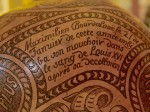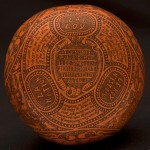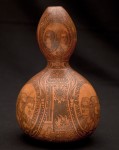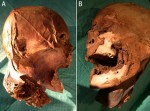 More than a century ago, an Italian family purchased a dried gourd of the Cucurbita moschata species (a species that includes several pumpkins and Butternut squash). This wasn’t just any old gourd. It already have a venerable history even a hundred years ago, once used as a flask for dispensing gunpowder. It was during the French Revolution that it reached its apotheosis, getting an elaborate pyrographic decoration. From top to bottom labeled portraits of revolutionary heroes like Marat, Danton, Robespierre and royalist victims like Louis XVI, Marie Antoinette and their son Louis-Charles were burned onto the gourd’s surface.
More than a century ago, an Italian family purchased a dried gourd of the Cucurbita moschata species (a species that includes several pumpkins and Butternut squash). This wasn’t just any old gourd. It already have a venerable history even a hundred years ago, once used as a flask for dispensing gunpowder. It was during the French Revolution that it reached its apotheosis, getting an elaborate pyrographic decoration. From top to bottom labeled portraits of revolutionary heroes like Marat, Danton, Robespierre and royalist victims like Louis XVI, Marie Antoinette and their son Louis-Charles were burned onto the gourd’s surface.
 Around the wide circular base of the bottle gourd were burned three inscriptions of particular interest with three slogans separating each inscription. Together they told a remarkable tale. The first reads: “Maximilien Bourdaloue le 21 de Janvier de cette année imbiba son mouchoir dans le sang de Louis XVI après sa Decollation.” In English: “Maximilien Bourdaloue the 21st of January of this year soaked his handkerchief in the blood of Louis XVI after his decapitation.” A cartouche inscribed “LA NATION” (The Nation) stands between the first and second inscriptions.
Around the wide circular base of the bottle gourd were burned three inscriptions of particular interest with three slogans separating each inscription. Together they told a remarkable tale. The first reads: “Maximilien Bourdaloue le 21 de Janvier de cette année imbiba son mouchoir dans le sang de Louis XVI après sa Decollation.” In English: “Maximilien Bourdaloue the 21st of January of this year soaked his handkerchief in the blood of Louis XVI after his decapitation.” A cartouche inscribed “LA NATION” (The Nation) stands between the first and second inscriptions.
 The second inscription: “Tout caillé le mis dans cette courge et me la ceda contre deux assignats de dix Francs. T. Pes c.f. L.er. F. Aegnauld.” In English: “Once congealed, he put it in this gourd and gave it to me for two banknotes of ten Francs. T. Pes c.f. L.er. F. Aegnauld.” I don’t know what the initials stand for, but I’m guessing it denotes some sort of religious order since F. probably means Frère or Brother. “LA LOY” or “The Law” is between the second and third inscriptions.
The second inscription: “Tout caillé le mis dans cette courge et me la ceda contre deux assignats de dix Francs. T. Pes c.f. L.er. F. Aegnauld.” In English: “Once congealed, he put it in this gourd and gave it to me for two banknotes of ten Francs. T. Pes c.f. L.er. F. Aegnauld.” I don’t know what the initials stand for, but I’m guessing it denotes some sort of religious order since F. probably means Frère or Brother. “LA LOY” or “The Law” is between the second and third inscriptions.
The third inscription: “Je me chargea des l’ouvrager ainsi pour en faire cadeau a’ l’Aigle qui viendra m’apporter ses Cinq Cent Francs.” In English: “I took it upon myself to have it decorated so I could make a present of it to the Eagle who will bring me his Five Hundred Francs.” Who the mysterious Eagle was we can’t know, but at some point the gourd was reputedly in the possession of Napoleon Bonaparte, future emperor of France whose imperial standard was an eagle. “LE ROY N’EST PLUS” or “The king is no more” is between the third and first inscription.
 In the middle is a crowned shield emblazoned with the name of the artist and the date on which he finished his extraordinary work “TERMINEE AUJOURD’HUI 18 DE 7EMBRE 1793 JEAN ROUX CITOYEN PARISIEN AUTEUR,” meaning “Finished today the 18th of September 1793 Jean Roux Citizen of Paris Artist.” A round of applause to Jean Roux of Paris and his remarkable gourd-burning talent. The date seems a little early for a Napoleon-as-eagle reference. He was in France then already making a name for himself as an able artillery captain. His political prospects also looked good, thanks to a pro-Revolutionary pamphlet he had written in July of that year which introduced him to Augustin Robespierre, Maximilien’s younger brother, who would become his friend and supporter. But he wouldn’t get his big splash until the Siege of Toulon which ended in December 1793 and made him a Brigadier General at the age of 24.
In the middle is a crowned shield emblazoned with the name of the artist and the date on which he finished his extraordinary work “TERMINEE AUJOURD’HUI 18 DE 7EMBRE 1793 JEAN ROUX CITOYEN PARISIEN AUTEUR,” meaning “Finished today the 18th of September 1793 Jean Roux Citizen of Paris Artist.” A round of applause to Jean Roux of Paris and his remarkable gourd-burning talent. The date seems a little early for a Napoleon-as-eagle reference. He was in France then already making a name for himself as an able artillery captain. His political prospects also looked good, thanks to a pro-Revolutionary pamphlet he had written in July of that year which introduced him to Augustin Robespierre, Maximilien’s younger brother, who would become his friend and supporter. But he wouldn’t get his big splash until the Siege of Toulon which ended in December 1793 and made him a Brigadier General at the age of 24.
 As for the handkerchief imbued with the arterial blood of the guillotined King Louis XVI, by the time the Italian family acquired the gourd, there was no hanky inside. There was dark residue, however, that could be dried blood. Wanting to know once and for all if their gourd once held the congealed blood of the benighted king, in 2011 the family contacted a geneticist at the University of Bologna and asked them to test the contents.
As for the handkerchief imbued with the arterial blood of the guillotined King Louis XVI, by the time the Italian family acquired the gourd, there was no hanky inside. There was dark residue, however, that could be dried blood. Wanting to know once and for all if their gourd once held the congealed blood of the benighted king, in 2011 the family contacted a geneticist at the University of Bologna and asked them to test the contents.
At first the scientists thought it was some weird joke, but the family has a letter from a French museum written about the gourd in 1900, and it’s a known fact that witnesses to the decapitations collected the blood of guillotined royalty as souvenirs and folk remedies. The researchers decided to have a go at it and see what they found.
 They were able to collect five samples of the dried residue from inside the gourd on which two laboratories ran three DNA tests: one on the Y chromosome, one on the HERC2 gene for blue eyes and one on the mitochondrial DNA. The results indicated that the residue was indeed dried human blood centuries old belonging to a blue-eyed male of a genetic makeup so rare that it couldn’t be found in any genetic database. Louis XVI had blue eyes and you know how weird those old royal family genes can get.
They were able to collect five samples of the dried residue from inside the gourd on which two laboratories ran three DNA tests: one on the Y chromosome, one on the HERC2 gene for blue eyes and one on the mitochondrial DNA. The results indicated that the residue was indeed dried human blood centuries old belonging to a blue-eyed male of a genetic makeup so rare that it couldn’t be found in any genetic database. Louis XVI had blue eyes and you know how weird those old royal family genes can get.
The researchers couldn’t confirm that it was the blood of Louis XVI, however, without comparing it to the DNA of someone in his direct family line, perhaps his poor son Louis-Charles, who died in prison in 1795 at the age of 10, purportedly of tuberculosis. His heart had been cut out by the doctor who performed the autopsy and went through various hands before being interred in 1975 in the royal crypt of Saint Denis cathedral. There was much controversy at the time over whether the real Louis-Charles hadn’t died but rather had escaped and been replaced with a random boy who was promptly killed. Those theories would put to rest once and for all in 2000, when a DNA test on the remains of the heart proved that it belonged to the son of Marie Antoinette.
 The researchers on the gourd blood hoped they might could get access to the heart themselves, but that was a long shot. Since the mitochondrial DNA results that identified Louis-Charles couldn’t help identify Louis XVI, the scientists went another way. They enlisted the mummified head of Henry IV, which had been identified in 2010.
The researchers on the gourd blood hoped they might could get access to the heart themselves, but that was a long shot. Since the mitochondrial DNA results that identified Louis-Charles couldn’t help identify Louis XVI, the scientists went another way. They enlisted the mummified head of Henry IV, which had been identified in 2010.
They sent a fiberscope through Henry IV’s trachea and collected a tissue sample from inside the head. They were able to retrieve mitochondrial DNA sequences and a partial profile of the Y-chromosome. The latter contained multiple alleles from the extremely rare haplotype that was found in the blood residue in the gourd. This is strong evidence that the two men were related in the paternal line and provides a DNA boost to the authenticity both of the mummified head and of the blood.
“This study shows that [the remains] share a genetic heritage passed on through the paternal line,” forensic pathologist Philippe Charlier told AFP. “They have a direct link to one another through their fathers. One could say that there is absolutely no doubt any more.”
“It is about 250 times more likely that [Henri’s] head and [Louis’] blood are paternally related, than unrelated,” co-author Carles Lalueza-Fox of the Institut de Biologia Evolutiva in Barcelona told the agency.
It would be “extremely surprising” if the remains did not belong to the two assassinated monarchs, he added.